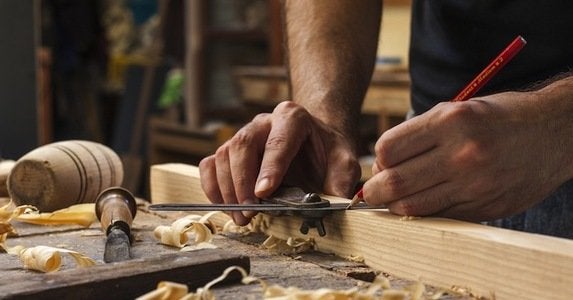Protective Gear
Even though you won’t be swinging a sledgehammer in full-on destruction mode, deconstruction is still dirty, dusty work. So gear up! That means good work gloves—preferably with leather palms to help prevent blisters—that are heavy duty enough to protect your hands but flexible enough to allow you to grip and use tools. Safety goggles are also a good idea, in case any debris accidentally goes flying. Kneepads are recommended, especially if you’ll be getting down on all fours to remove flooring, but not necessarily required. Finally, don a thin cotton mask if you’ll be kicking up dust, and a respirator if there's a chance that any harmful substances, such as asbestos or lead paint, may be present.
Nail Puller
Perhaps the most time-consuming part of deconstruction is nail removal, especially if you're dismantling wood floors. Skip the cat’s paw pry bar, which is bound to do damage, in favor of a nail puller with jaws that open and close around the nailhead. This type of hand tool has a built-in striker that lets you grab the nail without marring the wood; then all you need to do is pull back on the fulcrum to extract everything from big spikes to small finish nails.
Trim Puller
One of the top new hand tools on the market, the Trim Puller is a deconstruction go-to for taking down molding and baseboard without damaging trim or surface. And its strengths don't stop there: The tool's design is versatile enough to tackle awide variety of jobs, such as tile, carpet, and flooring removal! It boasts a larger, wider, and flatter edge than a pry bar as well as a built-in 15-degree center wedge that fits neatly between trim and walls. Just a tap of a hammer is all it takes for easy, efficient removal with no dings, dents, holes, or cracks. And it’s a pleasure to use: solid but not heavy, with an impact-absorbing EPDM handle that features a comfort grip.Available atTrimPuller.com;34.95美元。
Screwdrivers
In any deconstruction project, you’ll rely on screwdrivers big time for removing any electrical outlets and switches from the walls in your work zone. In kitchens and bathrooms, screwdrivers are also essential for cleanly removing base and wall-mounted cabinets. For deconstruction projects as well as a slew of other household tasks, you should be sure to stock a basic screwdriver set that includes a long flathead, a standard-size flathead, and at least one Phillips-head screwdriver.
Basin Wrench
如果你希望救助水槽和水龙头洗澡room or kitchen renovation, you’ll need to call in an assist from this ingenious plumbing tool: the basin wrench. Its long bar makes it easy to reach up into tight places, while the clamp end grips onto mounting nuts. Note: For hard-to-reach nuts, you may need to resort to a telescoping basin wrench. Just don't forget to shut off the water supply to the sink before you get started!
锤
You probably think of a hammer mostly for nailing things on, not taking thingsoff, but hammers come in handy during deconstruction too. You’ll need one to drive your Trim Puller between wall and trim, for instance, and you may find a tap of the hammer necessary when using a nail puller or wrench as well. A claw hammer, in particular—one with a flat, beveled, or patterned face for driving nails in and a claw end for pulling them out—is a carpentry must-have. You may also want a club hammer in your tool chest, which functions like a small sledgehammer, since even the most thoughtful deconstruction project may entail a bit of demolition.
Cellphone
Finally, here’s one deconstruction tool you may not have seen coming! No, we're not suggesting that you'll need a mobile phone to call in a pro for your DIY job. Instead, keep a phone handy for taking pictures of your job in progress. Having photos of how something looked before and during removal may serve as a valuable reference when you’re ready to reinstall your salvaged pieces at the end of a project.
Don't Miss!
Clever project ideas and step-by-step tutorials delivered right to your inbox each and every Saturday morning—sign up todayfor the Weekend DIY Club newsletter!
















